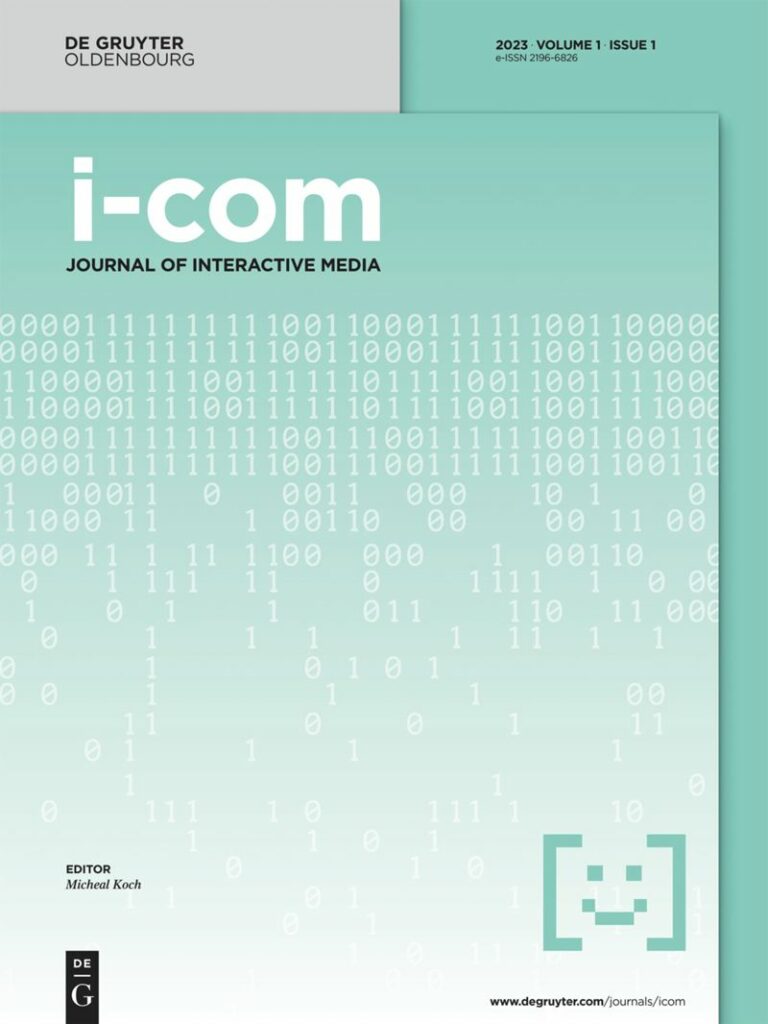Dear reader!
Finally, we made it! After the transition from a classic publication model to Golden Open Access at the beginning of this year, i-com is now officially listed in the Directory of Open Access Journals (DOAJ). This will surely help authors to get funding for the Open Access Article Processing Charges (OA APCs) in the future.
Regarding indexing and tracking citations we are happy that Scopus is covering i-com for some time already, and that i-com currently scores 3.5 on Scopus Cite Score – having grown rapidly from a 0.8 back in 2018. This partly is due to the better visibility of i-com content since going to Open Access beginning of this year with our publisher de Gruyter opening articles from all older volumes to free access.
What is now missing is the assignment of an impact factor to i-com. This will be handled by our application to the Web of Science Emerging Sources Citation Index (ESCI). So, everything is well on track to further establish i-com as a decent international journal on Human-Computer Interaction topics.
To further support the positive development of i-com from a content perspective, in 2024 we are planning two future-oriented special issues – first Issue 1/2024 on “CSCW – Past, Present and Future” and second Issue 2/2024 on “The Future of Human-Computer Interaction”. In the latter special issue we would like to present interesting but scientifically explainable and technologically sound forecasts for the next decades to discuss them further in our HCI community. We are curious about what the community will contribute to this issue.
But back to the present:
For this third issue in 2023 we have not arranged a special issue topic but have collected latecomers to the spe-cial issue on “Augmenting Usability Evaluation” and have added some free submissions.
“Test automation for augmented reality applications: a development process model and case study” by Sascha Minor, Vix Kemanji Ketoma, and Gerrit Meixner presents a concept for test automation of AR applications. The concept consists of two parts: design guidelines and process model for testing AR applications, and a case study with a prototype application for test automation.
“The Method Radar: a way to organize methods for technology development with participation in mind” by Marc Schmidt, Stefan Bente, Bruno Baruque Zanón, and Ana Maria Lara Palma addresses the issue of making user participation more visible in method taxonomies. The article presents the Method Radar, a visualized cate-gorization of methods with a focus on participation using the ladder of participation, that makes participation visible right at the beginning of any method selection.
“User-centered design in mobile human-robot cooperation: consideration of usability and situation awareness in GUI design for mobile robots at assembly workplaces” by Christian Colceriu, Sabine Theis, Sigrid Brell-Cokcan, and Verena Nitsch shows an exemplary approach to design a graphical user interface (GUI) for mobile human-robot cooperation at assembly workplaces. The process demonstrates a combination of methods that leads to high usability and situation awareness in mobile HRC.
“Introducing VR personas: an immersive and easy-to-use tool for understanding users” by Philipp Maruhn, Lo-renz Prasch, Florian Gerhardinger, and Sophia Häfner takes up the idea of personas to improve building empathy and establishing an emotional relationship between developers and users. The authors present a new approach to experiencing personas beyond traditional means such as posters or slides. With the help of virtual reality, they create immersive, three-dimensional personas that can be visited in their own living room.
“Read for me: developing a mobile based application for both visually impaired and illiterate users to tackle reading challenge” by Zainab Hameed Alfayez, Batool Hameed Alfayez, and Nahla Hamad Abdul-Samad ad-dresses the task of designing a mobile based application for helping visually impaired and illiterate users reading texts.
Finally, “AnswerTruthDetector: a combined cognitive load approach for separating truthful from deceptive an-swers in computer-administered questionnaires” by Moritz Maleck and Tom Gross presents a combined approach of two cognitive-load-based lie detection approaches. The authors address study administrators who conduct questionnaires in HCI, wanting to improve the validity of questionnaires.
I hope you enjoy reading the contributions in this third issue of Volume 22 of i-com – Journal of Interactive Media.
Michael Koch (Editor-in-Chief)

